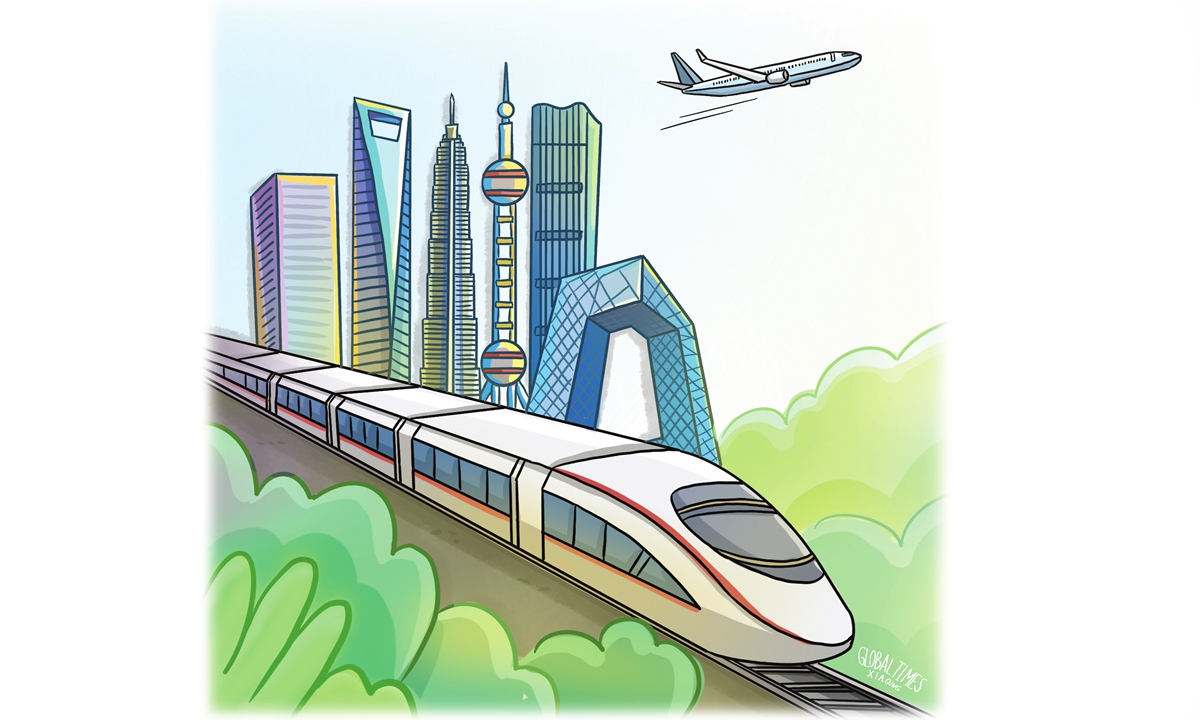75 years of evolution: China’s consumption evolves and unfolds unlimited potential
China’s bike industry witnesses Chinese people’s evolving consumption pattern

A bike relay race in Hangzhou, East China's Zhejiang Province on September 22, 2024. Photo: VCG
Editor's Note:
October 1, 2024 marks the 75th anniversary of the founding of the People's Republic of China. Over the past 75 years, under the strong leadership of the Communist Party of China, the country has made remarkable progress in social and economic development. From a once backward agrarian society, China has transformed itself into the world's second-largest economy, increasingly interconnected with the global economy and offering significant opportunities to the rest of the world. To illustrate this, the Global Times is publishing this series of articles, with the second installment focusing on China's continuous opening-up.
It's 9 pm on Beijing's Chang'an Avenue.
Thirty-year-old Ma Yuqiang, an experienced cyclist from Beijing, waits patiently at a busy intersection, eager for the green light to continue his ride.
Interestingly, the same bicycle congestion has caught Ma's parents before, in the 1980s.
Yet, it is the younger Ma's bike that reflects a sea change in Chinese people's consumption pattern. His bike costs 100,000 yuan ($14,202), while his father's was less than 200 yuan.
In documentaries documenting China in the 1980s, scenes of bicycle flows carrying plainly dressed Chinese along Chang'an Avenue are iconic. For people back then, bicycles were their means of transportation and even the most valuable "asset" in their homes. China is known as the "bicycle kingdom" in the world.
"In the 1970s, my father's Phoenix brand 28-inch bicycle was the pride of our family. Bikes were the vehicle of transportation for most people back then, and in the 1980s, the streets and alleys of Beijing were full of cyclists and a sea of bicycles is parked in front of Tian'anmen Square," Ma recalled.
Decades have passed, and although China remains the world's foremost bicycle kingdom, both the cyclists and the bicycles they ride have undergone tremendous changes, reflecting an evolving picture of Chinese people's consumption pattern.
Since the founding of the People's Republic of China 75 years ago, with the deepening of market-oriented reforms, China's commercial circulation and consumption have achieved historic leaps, the National Bureau of Statistics (NBS) said in a post on its website on September 11.
The scale of retail sales has steadily expanded, the consumption structure has been continuously optimized and upgraded, the supply market has gradually improved, and the quality and efficiency of the circulation system have continued to improve, noted the NBS.
From function to fun
After turn of the century, as Chinese consumers pursue efficiency and productivity and China's cities grew larger, millions of Chinese switched from bicycles to cars. This shift, alongside the growth of China's automotive industry, spurred a surge in car ownership, making China the world's largest automotive market. According to NBS data, China's car ownership reached 49.7 units per 100 households by the end of 2023, 2.9 times that of 2013.
The shift from bicycles to cars was just the tip of the iceberg in changing Chinese consumption patterns. The other big-ticket items of the average Chinese household also experienced a giant leap to greater quantity and quality with Chinese people's growing income, benefiting domestic and foreign companies in the process.
Measured by the average number of color TV sets, refrigerators, and washing machines owned by every 100 urban Chinese households, the numbers are only 0.6, 0.2 and 6.3 in 1981. By the end of 2023, the set of numbers has been vastly boosted to 107.8, 103.4, and 98.2.
Also, the incomes of Chinese residents have grown dramatically over the past 75 years, rising from 49.7 yuan (about $7 dollars) in 1949 to 39,218 yuan in 2023, an increase of 75.8 times, data from the NBS showed.
As the nation's economic strengths grew along with the reform and opening-up, the consumption pattern of Chinese consumers have shifted from merely meeting material needs to focusing on quality and service-oriented consumption, and has transformed from physical consumption that meets the needs of everyday life to service consumption that embodies the needs of a better life, analysts said.
Driven by the continuous increase in income levels and changes in consumption concepts, the trend of consumption upgrading is becoming increasingly pronounced, driven by growing incomes and evolving consumer preferences.
As the country moved from the era of scarcity to the era of abundance, the story of the bicycle continues.
"Entering the 21st century, mountain biking became a fad, and young people have become obsessed with outdoor cycling. Bicycles have gradually transitioned from being mere transportation tools to becoming symbols of entertainment and lifestyle," Ma, who spent 170,000 yuan on his two bikes, said. "This reflects not only increased disposable income but also a shift in spending toward health, entertainment, and cultural enrichment."
Diversified consumption
Analysts noted that as China became the world's largest manufacturing nation, with its large industrial capacity continues to supply the market with loads of commodities in ever increasing quantity, those supplies are more consumer-oriented and catering to the specific needs of the average Chinese consumer.
By 2023, the number of items of consumer goods registered by the State Administration of Market Regulation has approached 200 million.
The transformation of the China market from oblivion to the world's second-largest consumer market is an epoch-making event in the history of global economic development, Bian Yongzu, executive deputy editor-in-chief of Modernization of Management magazine, told the Global Times on Tuesday.
"China's vast and rapidly expanding consumer market, strong purchasing power of Chinese consumers, and their wide array of demands provide huge room for foreign companies to generate revenues and experiment innovations," Bian said.
For example, the renewed popularity of cycling reflects a growing focus on low-carbon travel, sharing economy, individuality, and an active lifestyle. These new trends have generated great market opportunities for domestic and foreign brands.
As the nation continues to implement the strategy of expanding domestic demand, introduce policies to boost consumption, enhance the alignment of supply and demand, continuously improve the adaptability of supply and demand, and cultivate new business formats and new models, analysts said that consumption will continue to be the "main engine" in driving China's economic growth and benefiting the world.



